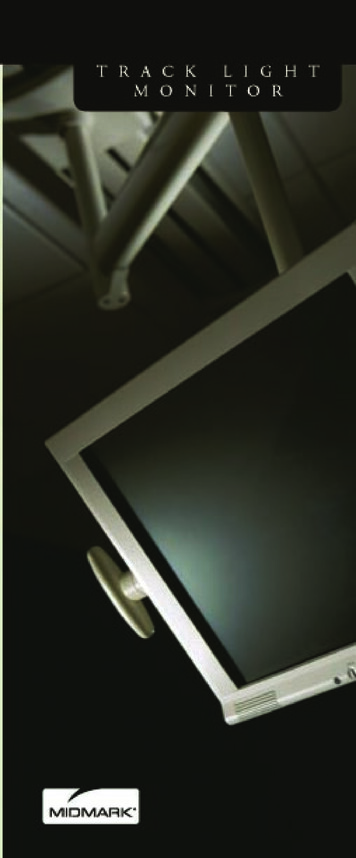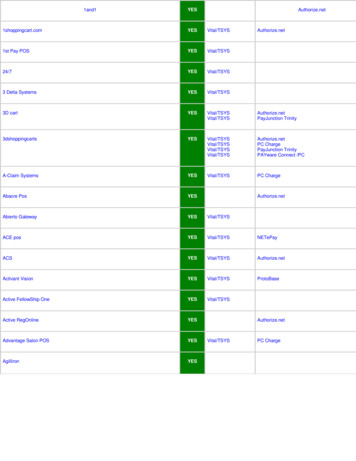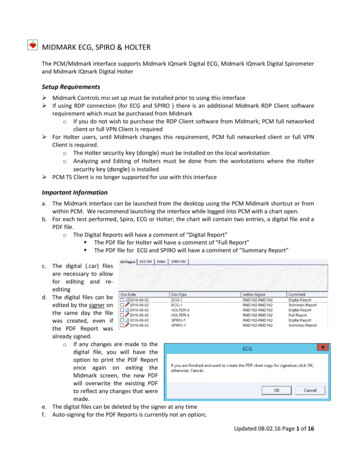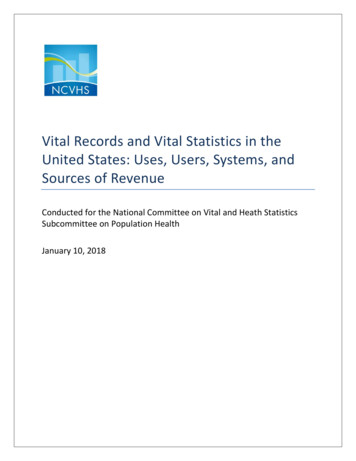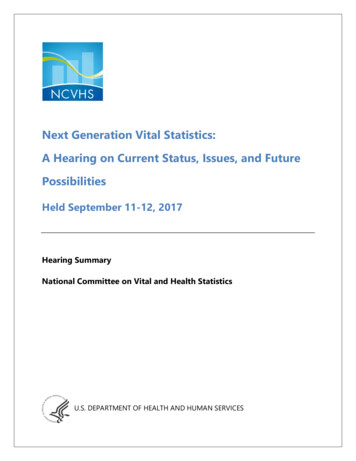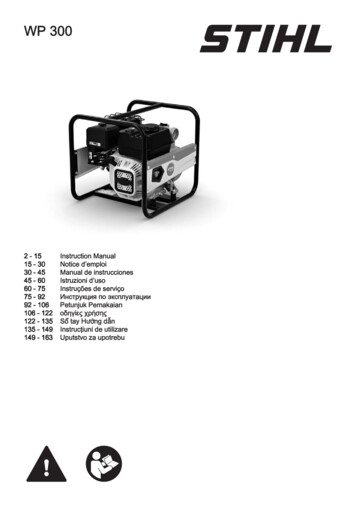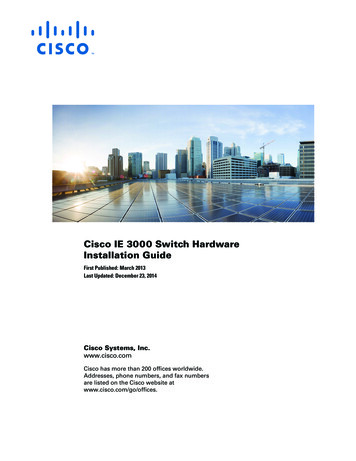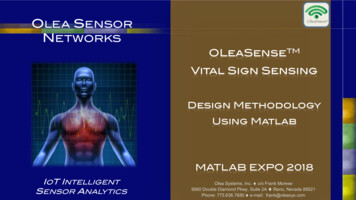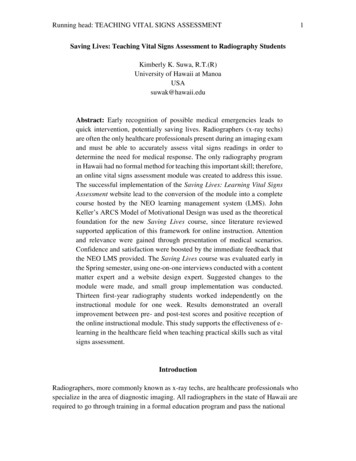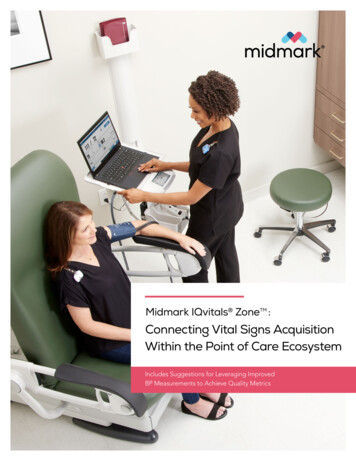
Transcription
Midmark IQvitals ZoneTM :Connecting Vital Signs AcquisitionWithin the Point of Care EcosystemIncludes Suggestions for Leveraging ImprovedBP Measurements to Achieve Quality Metrics
This is part two of the Midmark Point of Care EcosystemSeries that examines how new technologies are creatinga fully connected point of care ecosystem in outpatientfacilities. The first paper, “Point of Care Ecosystem: FourBenefits of a Fully Connected Outpatient Experience,”defined the point of care ecosystem and presented thebenefits that healthcare organizations can realize from anecosystem that enhances patient-caregiver interaction.This second installment focuses on one particularinnovation that is helping establish and expandconnectivity within the point of care ecosystem:Midmark IQvitals ZoneTM Vital Signs Monitor.Midmark ZoneTM technology can be utilized to minimizeconnectivity challenges within ambulatory and outpatientfacilities by simplifying how caregivers interact with—andconnect to—equipment and devices in the exam room.2 Midmark IQvitals Zone: Connecting Vital Signs Acquisition within the Point of Care Ecosystem
The Connected Point of Care EcosystemAs defined in the first paper in this series, a point of care ecosystem goes beyond the directinteraction between patients and caregivers to encompass everything that happens withinthe practice or clinic, as well as experiences that occur outside of this environment. For mosthealthcare organizations, the exam room is comprised of disconnected processes, devicesand workflows that can prevent seamless, well-coordinated patient experiences. Additionally,isolated processes and disconnected data flows can contribute to inefficiencies, communicationbreakdowns and human errors.A fully connected point of care ecosystem is becoming more of a reality as new technologieswith greater connectivity are introduced to the industry. A connected ecosystem integratesprocesses, equipment and caregivers at the point of care to significantly enhance the patientcaregiver experience and improve the quality of ambulatory care. It also helps ensure a moresatisfying, seamless patient experience by providing a platform where organizations canleverage new technologies, incorporate best practices and employ greater standardization toimprove quality of care and outcomes.The benefits resulting from a fully connected ecosystem include:1. GREATER VISIBILITY into a patient’s health history is gained through automating vital signsacquisition. Trends and fluctuations in health history are more easily identified when readingsare acquired using the same method each visit, rather than reviewing charts that may containvariations in manual techniques.2. STANDARDIZATION enables organizations to develop clinical protocols that drive optimaloutcomes by helping eliminate human variables that can increase the opportunity for humanerrors and lead to inaccurate diagnoses. For instance, some studies have shown a 17% errorrate in manual clinical documentation of vital signs at various locations of care delivery.13. GREATER EFFICIENCY is achieved by allowing healthcare organizations to identifyopportunities to enhance and improve processes and workflows. Caregivers andpractice administrators can better track the progress and success of initiatives designedto increase efficiencies and cost savings.4. ENHANCED PATIENT-CAREGIVER INTERACTION is essential for effective clinicalinteractions and achieving optimal outcomes. By understanding the time patients and staffspend on specific activities within the clinical space, as well as how rooms and equipmentare utilized, healthcare organizations can make better decisions and deliver a patientcentered experience at every encounter.3 Midmark IQvitals Zone: Connecting Vital Signs Acquisition within the Point of Care Ecosystem
Midmark IQvitals Zone Vital Signs MonitorMidmark IQvitals Zone (Figure 1) can minimize connectivity challenges within ambulatory settingsas outpatient facilities begin to create a connected ecosystem. This vital signs monitor is the firstdiagnostic device to feature Midmark Zone technology. Zone technology enables the IQvitalsZone monitor to auto-connect to a computer through a secure Bluetooth Low Energy connectionwithout the need for cables or manual pairing. This helps caregivers effortlessly and securelyconnect their tablet or laptop to the device when they place it on or near IQvitals Zone to initiatevital signs acquisition.FIGURE 1. Midmark IQvitals Zone allows caregivers to centralize vital signs acquisition at the point of care. In-room and mobile versionsof the diagnostic device provide flexibility and multiple workflow options for caregivers.IQvitals Zone transforms the traditional vital signs acquisition process by establishing a direct wirelessconnection between the vital signs monitor and the caregiver’s tablet or laptop. IQvitals Zoneeliminates the need to manually connect and disconnect by auto-connecting when the caregiver placestheir laptop on the multi-use work surface or near the diagnostic device—it automatically disconnectswhen the tablet or laptop is moved away from the device.When connected, caregivers can capture vital signs measurements, review results and seamlesslyimport the information into an electronic medical records (EMR) system. Additionally, if the exam roomincludes a Midmark 626 Barrier-Free Examination Chair with integrated Digital Scale, caregivers candirectly capture weight data from the chair and send it to the EMR. This can all be done through asingle pane of glass, allowing caregivers to perform device functions and import data into the EMRwithin one computer screen, as opposed to interacting with multiple device screens in various locationsthroughout the room or facility.4 Midmark IQvitals Zone: Connecting Vital Signs Acquisition within the Point of Care Ecosystem
Midmark IQvitals Zone Technology BenefitsFollowing is how Midmark Zone technology contributes to the four primary benefits of aconnected point of care ecosystem.GREATER VISIBILITYIQvitals Zone provides caregivers with greater visibility into a patient’s health history byoffering consistent, reliable measurement and documentation of patient vital signs. This allowscaregivers and patients to more easily track important health status and trends of chronic diseaseconditions—which ultimately leads to better patient care, disease management, treatmentdecisions and clinical outcomes.For instance, IQvitals Zone provides caregivers with six automated modes for blood pressure(BP) measurement to help ensure more consistent, accurate readings. Spot mode takes a singlenoninvasive BP (NIBP) reading. Interval mode acquires a series of NIBP readings at selectedintervals until the user elects to finish the monitoring session. Continuous mode achievescontinuous BP measurements for five minutes. Averaging mode automates a series of fivereadings, eliminates the first reading and displays the average of the remaining four readings asthe patient’s average BP. The SPRINT BP protocol feature adheres to the measurement processoutlined in the Systolic Blood Pressure Intervention Trial (SPRINT), allowing for a five-minute restbefore taking three measurements (each a minute apart) and then averaging the BP readings.The Custom BP protocol allows the user to customize BP measurement based on the SPRINTBP protocol.Automated vital signs acquisition can provide the consistency that is key to accuracy, especiallyfor a measurement that is the foundation for so many decisions about a patient’s health.STANDARDIZATIONCurrently, many healthcare organizations are working to implement a higher level ofstandardization into their processes and procedures. Midmark Zone technology introducesautomation and connectivity at the point of care that can help ensure a higher level ofstandardization, minimizing human variables while maximizing consistency and data accuracy.The automation introduced by IQvitals Zone can assist in facilitating the repeatable adherenceto a health system’s clinical guidelines for proper BP measurement techniques, helping achievemore accurate, consistent and reliable BP measurement for all patients. This is especiallyevident when IQvitals Zone is used in conjunction with a connected exam chair that helpsposition the patient in accordance with American Medical Association (AMA) guidelines forproper BP measurement. Caregivers who use IQvitals Zone are better equipped to achievemore accurate, consistent and comparable BP measurements.5 Midmark IQvitals Zone: Connecting Vital Signs Acquisition within the Point of Care Ecosystem
It has also been shown that manual BP readings can produce inconsistent results. One research studyfound that automated capture tends to produce numbers lower than manually taken readings by asmuch as -10.8/-3.1 mmHg (systolic/diastolic error).2 When the data collection process is automated andstandardized, consistency and precision is achieved between care sites, equipment and providers. Thismeans increased confidence in the data collected, which ultimately can lead to better clinical decisionsand patient care. This is especially important given the issues created by inaccuracies inBP measurement, which we discuss later in this paper.The new level of connectivity provided by Midmark Zone technology protects the quality of data byvirtually eliminating the risk of human errors occurring at the keyboard. IQvitals Zone directly importspatient vital signs data into the EMR, eliminating manual transcription errors and providing greaterconfidence in data accuracy. As mentioned previously in this paper, studies have shown that manualtranscription of data produces a 17% rate of error on average.1 Assuming a practice sees 20 patients aday, that can equate to approximately 20 avoidable errors each day.3The standardization enabled by automation and connectivity also establishes a platform that reinforcesworkflows for existing protocols. Over time, the platform can serve as a mechanism when consideringand implementing new workflows that follow industry best practices.GREATER EFFICIENCYThe vital signs acquisition process hasn’t changed significantly in the last 30 years. Today’s processesoften include multiple stations in a facility to capture vital signs (BP, temperature, pulse and SpO2), weightand height. Some locations are in semi-public spaces, which can lead to patient discomfort and privacyviolations. By establishing a connected point of care ecosystem where all vital signs as well as weight andheight can be captured in one location, IQvitals Zone can assist caregivers in creating a more efficientvital signs acquisition process.Centralizing the vital signs process at the point of care using IQvitals Zone reduces the need to movepatients through different stations to capture necessary vital signs data. By automating the process,IQvitals Zone can capture multiple vital signs measurements simultaneously. And by providing adirect, wireless connection between the vital signs monitor and the clinician’s tablet or laptop,IQvitals Zone technology eliminates the need for manual data entry and the associated risk ofmanual transcription errors.At a most basic level, Midmark Zone technology allows caregivers to easily move from room to room,automatically connecting to and disconnecting from the vital signs monitor as they move in and out ofrange. (Figure 2) Traditionally when caregivers enter a room, they are required to manually connecttheir laptop or tablet to the vital signs device. The login can require as many as three to five clicksevery time the caregiver enters the room, and that does not include any of the steps necessary todisconnect before leaving the room. This is valuable time that could be better spent focused onthe patient.6 Midmark IQvitals Zone: Connecting Vital Signs Acquisition within the Point of Care Ecosystem
FIGURE 2. Caregivers using IQvitals Zone can automatically connect their tablet or laptop to the vital signs monitor. With zero clicks and nocables to connect, the caregiver has more time to focus on the patient.ENHANCED PATIENT-CAREGIVER INTERACTIONPatient-caregiver interaction in the exam space is a foundational element in the continuum of care. Forthat reason, every aspect of IQvitals Zone is designed to ensure that interaction at the point of care isimproved. For instance, the diagnostic device features a built-in work surface where caregivers can placetheir laptops. This eliminates the need for a separate computer cart or Mayo stand. With the laptop andvital signs monitor located together, providers can more effectively maintain eye contact with patients,helping improve interaction and intimacy during patient visits.Also, with vital signs acquisition now streamlined and simplified through automated data transfer and anew level of connectivity, caregivers can spend more time with the patient. Less time clicking and moretime listening and engaging the patient can result in a better experience and better care.For patients, IQvitals Zone technology helps ensure a consistent experience and alleviate concerns theymay have regarding potential errors resulting from inaccurate vital signs acquisition or manual data entry.Patient peace of mind and comfort are important factors in driving high patient satisfaction, which isgrowing in importance in the healthcare industry. When patients and providers are comfortable in theirenvironment and realizing gains in time and accuracy through efficiency and automation, better care andoutcomes are possible.7 Midmark IQvitals Zone: Connecting Vital Signs Acquisition within the Point of Care Ecosystem
Midmark IQvitals Zone Technology BP MeasurementAs mentioned previously in this paper, IQvitals Zone helps eliminate human variables that increase thelikelihood of errors that can contribute to inaccurate diagnoses. Of all the vital signs, BP measurementhas perhaps the strongest connection to point of care diagnosis, patient risk stratification and medicationdosing. These three critical factors of care management are essential to precise decision-making.Because of its centrality in care, it is essential that BP assessment is as accurate as possible.In order to properly diagnose and treat hypertension—a major risk factor for coronary heart disease,stroke and renal failure—caregivers need accurate BP measurements, both current and trending. Itis also becoming increasingly important to detect small differences in BP readings in the treatmentof patients with diabetes and renal diseases, making accurate trending data and standardizedprotocols even more critical.Unfortunately, despite the availability of highly accurate automated devices such as IQvitals Zone andequipment that positions the patient in precisely the correct manner, such as the Midmark 626 BarrierFree Examination Chair, BP measurement continues to be one of the most inconsistently performedtests in the clinical environment. According to the AHA, numerous surveys have shown that physiciansand other healthcare providers rarely follow established guidelines for BP measurement. However, whenthey do, the readings correlate much more closely with more objective measures of blood pressure thanthe usual clinic readings taken when not following the guidelines.4 As Chart 1 shows, there are a numberof factors that can affect the accuracy of BP measurement.FACTORS AFFECTING ACCURACY OF BLOOD PRESSURE MEASUREMENTS 5,6FactorSystolic BP Discrepancy (mmHg)*Diastolic BP Discrepancy (mmHg)*Patient talking or active listening 10 - 15 10Arm is above heart level-2 per inchArm is below heart level 2 per inchPatient’s feet not flat on the floor 5 - 15Patient’s back not supported 5 - 15 6 - 10Patient’s legs crossed 2 - 8 2 - 8Unsupported arm 6 - 10 5 - 11Patient doesn’t rest 3-5 minutes 10 - 20White coat syndrome 11 - 20*Factor discrepancies are not cumulative.CHART 1. A number of factors can cause discrepancies with systolic and diastolic blood pressure measurement.8 Midmark IQvitals Zone: Connecting Vital Signs Acquisition within the Point of Care Ecosystem
BP readings can vary when obtained by different members of a care team. Two different caregiversindependently acquiring BP measurements using manual methods on the same patient can oftenobtain two different readings. With IQvitals Zone , human variations are minimized by normalizingand automating the BP measurement process.Because IQvitals Zone automatically transmits patient vital signs data directly to the EMR, errors due tomanual transcription are also eliminated. This added functionality allows the care team to use the toolswithin the IQvitals Zone solution to standardize all stages of the vital signs collection process. In the end,the patient and care team experience a more streamlined and efficient interaction, which ultimately leadsto improved satisfaction and quality metrics.IQvitals Zone has achieved the level of precision necessary for clinically accurate point of care BPmeasurement. Supporting validation studies at a leading independent laboratory demonstratingconsistent top tier performance by IQvitals Zone were reviewed by Dr. Bruce Alpert, a renownedexpert in BP measurement:MIDMARK IQVITALS ZONE: BLOOD PRESSURE ACCURACY VALIDATION REVIEWBRUCE S. ALPERT, MDFor the past 40 years, the American National Standard, a document that describes the protocolnecessary to demonstrate accuracy of an automated BP device, has been written by a committee namedby the Association of the Advancement of Medical Instrumentation (AAMI). In the past decade, thiscommittee has joined forces with the International Organization of Standards (ISO) to produce one worldwide standard for BP accuracy testing, the ANSI/AAMI/ISO 81060-2:2019 Standard.7 Passing the accuracyrequirements of this standard is the ultimate validation test for an automated BP device.The Standard requires testing on at least 85 subjects whose systolic BP measurements range from 100 mmHg to 160 mmHg. The required diastolic BP range is from 60 mmHg to 100 mmHg.There are additional requirements related to arm size and gender. Two statistical targets must beachieved for both systolic BP and diastolic BP: Criterion 1 requires that the mean of the BP values, whencompared to traditional two-observer auscultation, be 5 mmHg with a standard deviation (SD) of 8mmHg. Criterion 2 is more complex, where the mean SD required to pass changes as the amount thedevice BP means differ from the manual by more than zero. To pass both criteria, thereby validating theautomated BP device, requires an algorithm of exceptional precision.The Midmark IQvitals Zone was tested, using a Midmark 626 Barrier-Free Examination Chair forproper patient positioning, at an independent research site well known for doing BP validation studies.The results of that testing are impressive, with each Standard criterion reaching a “passing grade” forthe device’s default step deflation algorithm. The Criterion 1 mean SD values and Criterion 2 SD values(Chart 2) were well within the allowed differences between the device and manual auscultation. Thus, theIQvitals Zone device passed every requirement of the Standard for complete validation.9 Midmark IQvitals Zone: Connecting Vital Signs Acquisition within the Point of Care Ecosystem
ANSI/AAMI/ISO81060-2:2019CriteriaStep Deflation(device minus manual BP readings/differences)SBP differences(mmHg)DBP differences(mmHg)Criterion 1(mean SD)1.22 6.3-1.67 6.09Criterion 2(SD)5.064.98SBP, systolic blood pressure; DBP, diastolic blood pressure; SD, standard deviationThe IQvitals Zone device is part of a novel integrated technology system when used in conjunction withthe Midmark 626 exam chair, which provides proper patient positioning capability for more accurateBP readings. This system reduces variations in accuracy due to failure to comply with American HeartAssociation and American College of Cardiology patient positioning recommendations during BPassessment. Using the Midmark IQvitals Zone device with the Midmark 626 examination chair shouldimprove the quality of care for all patients.Dr. Alpert is a pediatric cardiologist who practiced for nearly 50 years. He is the former physician chair of the AAMI SphygmomanometerCommittee and represented the USA on the International Organization for Standardization (ISO) Technical Committee, ISO/TC 121/SC 3“Respiratory devices and related equipment used for patient care”, for the update to the current ANSI/AMMI/ISO 81060-2:2019 standard.1Fieler VK, Jaglowski T, Richards K. Eliminating errors in vital signs documentation. Comput Inform Nurs. 2013 Sep;31(9):422-7; quiz 428-9.doi:10.1097/01.NCN.0000432125.61526.27. PMID:240807512Wahi MW, Parks DV, Skeate RC, Goldin SB. Reducing errors from the electronic transcription of data collected on paper forms: a research datacase study. JAMA 2008 May 1; 15(3): 386–389. PMID:183089943Error rate equation: (20 patients)(6 vital signs per patient)(17 percent errors) 20.4 errors per day4T. Pickering, J. Hall, L. Appel, B. Falkner, J. Graves, M. Hill, D. Jones, T. Kurtz, S. Sheps, E. Roccella. Recommendations for blood pressuremeasurement in humans and experimental animals: Part 1: Blood pressure measurement in humans: A statement for professionals fromthesubcommittee of Professional and Public Education of the American Heart Association Council on High Blood Pressure Research. Journal ofHypertension (2005) 45:142-161. PMID:156113625E. O’Brien, R. Asmar, L Beilin, Y Imai, J. Mallion, G. Mancia, T. Mengden, M. Myers, P. Padfield, P. Palatini, G. Parati, T. Pickering, J. Redon, J.Staessen, G. Stergiou, P. Verdecchia. European Society of Hypertension recommendations for conventional, ambulatory, and home bloodpressure measurements. Journal of Hypertension (2003) 21: 821-848. PMID:127148516J. Long, J. Lynch, N. Machiran, S. Thomas, K. Malinow. The effects of status on blood pressure during verbal communication. Journal ofBehavioral Medicine (1982) 5:165. PMID:71315407ANSI/AAMI/ISO 81060-2:2019. Non-invasive sphygmomanometers - Part 2: Clinical investigation of intermittent automated measurementtype. d-3:v1:en10 Midmark IQvitals Zone: Connecting Vital Signs Acquisition within the Point of Care Ecosystem
Midmark IQvitals Zone can be a significant stepforward in the effort to establish a fully connectedpoint of care ecosystem. By further integrating vitalsigns acquisition and caregiver mobile computinginto the point of care, IQvitals Zone improvesclinical workflow and accuracy, EMR connectivityand patient care efficiency, while providing aplatform for future capabilities to further advancequality of care and clinical outcomes.11 Midmark IQvitals Zone: Connecting Vital Signs Acquisition within the Point of Care Ecosystem
Bluetooth is a registered trademark of Bluetooth SIG, Inc. 2021 Midmark Corporation, Miamisburg, Ohio USA007-10168-00 Rev. C1
The new level of connectivity provided by Midmark Zone technology protects the quality of data by virtually eliminating the risk of human errors occurring at the keyboard. IQvitals Zone directly imports patient vital signs data into the EMR, eliminating manual transcription errors and providing greater confidence in data accuracy.
